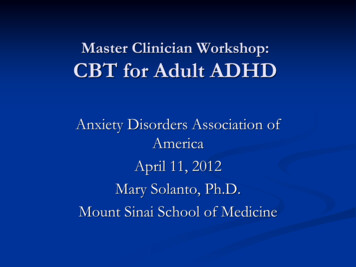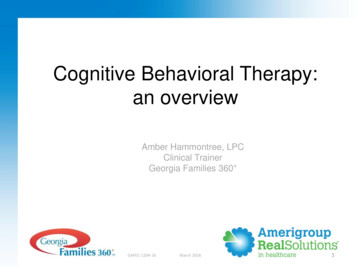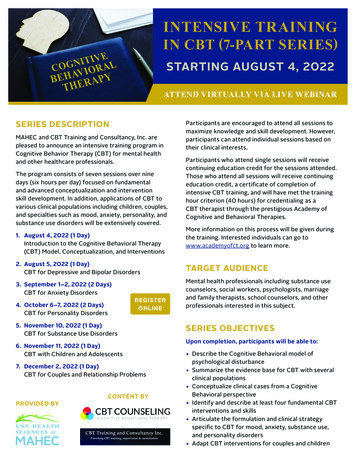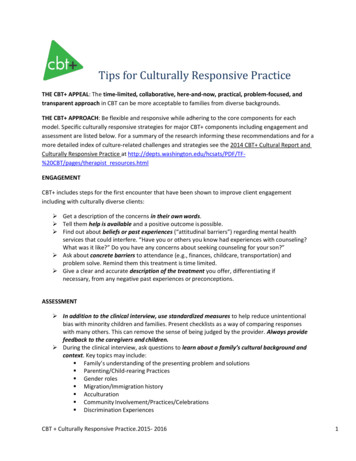
Transcription
Master Clinician Workshop:CBT for Adult ADHDAnxiety Disorders Association ofAmericaApril 11, 2012Mary Solanto, Ph.D.Mount Sinai School of Medicine
Mary V. Solanto, Ph.D.Disclosure of Potential ravel)Stock orEquity 10,000Honorariumor expensesfor thispresentationor meeting
Plan Background and Overview Rationale Goals Underlying Principles Major ComponentsClinical Guidelines Selection of Candidates Style of Presentation Roundtable Inquiry of Home ExerciseTherapist Manual Overview of Sessions Modification for Individual Therapy
Rationale for PsychosocialIntervention Inadequate medication response or untowardeffects in 20-50% of adults (Wilens, 2002)Definition of Medication “response” 25-30% reduction in core symptomsResidual deficiencies in time management,organization and planning (TOP) skills, evenamong medication responders.
Rationale for PsychosocialIntervention (continued) Lack of development of “meta-cognitive” skillsin childhood due to ADHD symptoms(Douglas; Barkley).Need to address psychiatric comorbidity (e.g.,anxiety and depression) and relateddysfunctional “automatic thoughts”Need to address ingrained, maladaptive behaviorpatterns, obstacles to change, and psychosocialimpact of ADHD
Targets of Treatment Problems with time-estimation (late and missedappointments) Procrastination, avoidance (failure to initiate) Failure to complete tasks, especially on boring, routine,non-gratifying tasks (e.g. bills, laundry, mail, taxes) Failure to STOP and shift to a new task as appropriate(failure to inhibit, misnamed “hyperfocus”) Difficulties with organization (losing and forgetting) Failure to follow through on long-term projects, life goals Measured using our “ON-TOP” questionnaire
Goals of Treatment Design Practical, “real”, easy to assimilate New meta-cognitive skills must be taught – e.g., filing system,steps in project planning New behaviors must be assimilated into all the activities ofdaily life in a way that becomes “habitual” and automatic Neuropsychologically informed Address impairing self-attributions Manualized - to be researched & replicatedSolanto, MV. Cognitive-Behavioral Treatment of Adult ADHD: Targeting ExecutiveDysfunction. Guilford Press, 2011
Cognitive-Behavioral GroupTreatment – Methods Impart explicit skills (e.g. filing system)Impart “rules” (adaptive internal speech) to guide dailyscheduling, prioritizing, self-activation, organizationContingent self-reinforcementVisualization of long-term rewards of present behavior Counteracting steeper delay-of-reinforcement gradientUse of traditional CBT to address demoralization,anxiety, and perfectionismIntensive practice, group support, positivereinforcement
Treatment Parameters Group modality (can be adapted for indivtherapy) Exclusive focus on “TOP” skills 12-sessions, 2 hours, 6-8 persons Components of each session Review of home exercisePresentation of new materialIn-session exerciseReview of upcoming Home exerciseHandouts summarize the session, home exercise
In-Session Exercises Break down complex tasks into parts Create a week’s schedule from to-do list Visualization of distant rewards Set up a filing system Sort a stack of papers from a typical desk Organize a physical space Plan a project using the flow chart
Prioritization Work 1 to 5)ScheduledforCompletedon
Project Flow Chart
Home Exercises Choose one procrastinated task of less than 1hour, schedule, complete it, and self-reinforce. Prioritize and schedule task list into a week. Select a space to be organized, divide into“zones”; schedule; complete one zone; selfreinforce. Plan a project (over 2 weeks) using flow-chart.
“Mantras” “If it’s not in the planner, it doesn’t exist.” “If I’m having trouble getting started, then the first stepis too big.” “All things must be done in the order of their priority.” “Getting started is the hardest part.” “A place for everything - and everything in its place”(organization) “Out of sight, out of mind” (distraction control)
Efficacy Study Sponsored by NIMH Treatment Development Award88 adults with ADHD randomly assigned to CBTGroup or Support GroupCBT superior via blind evaluator, self- and otherreportSolanto, M. V., Marks, D. J., Wasserstein, J., Mitchell, K.,Abikoff, H., Alvir, J. M., & Kofman, M. D. (2010). Efficacy ofmeta-cognitive therapy (MCT) for adult ADHD. American Journalof Psychiatry, 167(8), 958-968.
Candidates Exclusions (ascertained in pre-group interview) Other more severely impairing condition E.g. severe anxiety, depression, suicidalityBorderline personality disorder Active alcohol, substance abuse Anger control problems ?Asperger’s, PDD Spectrum Extreme verbal impulsivity/insensitivity to social cues
Screening Visit To confirm diagnosis of ADHD viaCurrent symptoms History Scores on standardized Questionnaires (eg.CAARS) To ascertain co-morbidities (eg. BDI, BAI)To prioritize current problems vis-à-vis choiceof treatmentsTo learn details of current life-situation,problems, goals.
Style of PresentationRoles the Leader Plays Cheerleader Warmly supportive and encouraging;Energizing, ExhortingTeacher Engaging style of presentation Socratic method – invites dialogue, active thinking Always get “real-world” material for Exercise from Group e.g. for project flow-chartUse visual cues – white-board for lists, diagramsDidactic – background, psychoeducational material, mantras etc.Therapist Know how to follow up disclosures in HEKnow when/how to probe defensesKnow when to (gently but firmly) hold patients accountableKnow when to let group do the theraputic work
Review of the Home Exercise Central Importance of the Home Exercise Sole significant predictor of outcome Comprises 50% of sessionFirm control of timing (need to be assertive)Exercises are intended to be cumulativeIf successful, praise. Solidify by asking: How did it feel?What did you do differently this time?What would you do in the future in same sit?
Review of the Home Exercise contIf not successful or only partially successful: Identify and address obstacles. Realistic or not?Trouble-shoot and cue the relevant strategy, for example: “Did you schedule it in your planner?”“Are you trying to do too much?“Did you break it down into parts?“Did you plan to reward yourself afterward?“Were you trying to work in an area with distractions?
Patterns of non-compliance with HE Manifestations: Started, but stoppedDid not start, but wanted toDid not start and did not want toCauses: Classic ADHDAnxiety about being overwhelmed/failing Depression/demoralization Shame at non-completion may lead to missing sessionDoubts about self-competencyUnable to summon the “energy of activation”Oppositionality
Treatment Manual 1. IntroductionTime Management 2. Time Awareness & Scheduling3. Making Tasks Manageable and Self-Reward4. Prioritizing and To-Do Lists5 (5-6) Overcoming Emotional Obstacles (via CBT)6. Activation and motivationOrganization 7. Setting up Organizational Systems8. Implementing Organizational Systems9. Maintaining Organizational Systems
Treatment Manual - cont Planning10. Plan a Project 11. Project Implementation 12. Conclusion, Summation, Future PlanningOptional Session: Going to bed, getting up and getting to work ontime.Optional Exercise: Planning a business or week day
Project Flow Chart
Modification for Individual TherapyIndications Advantages of Individual Treatment Allows for focus on specific areas of deficitAllow for progress at the individual’s paceAllows opportunity to address resistanceFlexible scheduling, privacyContraindications for Group Treatment: Significant anger management problemsActive drug or alcohol abuseOther severe psychopathologySocial Phobia (usually self-select out)
Modification for Individual TherapyMethods Guided Inquiry of Skills Corresponds to Hierarchy of Skills keyed to sessions
Hierarchy of Skills Keyed to Sessions
Hierarchy - continued
Modification for Individual Therapy– continued Setting and Adhering to the AgendaBalance between maintaining structure andresponding to current emotional needs/issues Importance of laying the groundwork Time Allocation (approximate)10-15 min for review of Home Exercise 20 min for new material 10-15 for review of new Home Exercise
Modifications for Individual TherapyReview of the Home Exercise Share expectation that home exercises will bechallengingRepeated failure to complete HE signalsemotional issues, resistanceAs in Group, query reasons for success/partialsuccess/failure; expansion of strategiesHE’s can be repeated to mastery
Modification for Individual TherapyTermination Decision to TerminateMastery of strategies OR Focus has shifted to emotional /personality issues Termination ProcessReview progress in treatment Anticipatory trouble-shooting/problem-solving Spaced follow-upEg. monthly for 1st month Then “as needed”
Lack of development of "meta-cognitive" skills in childhood due to ADHD symptoms (Douglas; Barkley). Need to address psychiatric comorbidity (e.g., anxiety and depression) and related dysfunctional "automatic thoughts" Need to address ingrained, maladaptive behavior patterns, obstacles to change, and psychosocial impact of ADHD











